In my previous blog posts, I've been covering Owenyo and Bartlett, plus operations and starting construction of my new HO scale layout. Let's have a closer look at one of the forgotten jewels in the Jawbone Branch story, the little town of Little Lake. The town has its roots back into the stage coach days and a supply post for the early mining operations going back as far as the Civil War!
My Little Lake Expansion
 |
| 1947 photo of the 'downtown' area of Little Lake. - OwensValleyHistory.com |
I've always enjoyed passing the Little Lake area during my many trips up and down US Hwy 395. The natural beauty of the location is spectacular, including one of the few natural lakes in the area formed by the the basaltic lava flows to the east. These dark colored flows form a nearly shear cliff several hundred feet high.
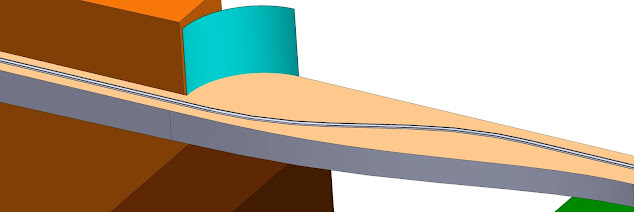 |
| My original concept for the space for Little Lake, which could be about 5ft long and flow through the S-curve. |
Originally, I planned to put a backdrop in with the image of the basalt bluffs east of Little Lake and a couple of buildings. Maybe the gas station and hotel that I knew existed there.
My more in depth research of Little Lake started with an Alden Armstrong photo I found, showing that there was more railroad infrastructure at Little Lake than 'just the hotel and gas station.' The photo shows a speeder shed, several old carbodies for the section gang, a small water tank and an dump ramp for loading gondolas from dump trucks. It also shows at least two tracks there. From that photo alone it was hard to work out exactly where this mysterious 'company village' for Little Lake was.
 |
| Carl White & "Grandpa Gurdy", Fishing at Little Lake against the lava bluffs - owensvalleyhistory.com |
Thankfully I found a great history page on the town of Little Lake, which somehow I missed in November 2020 when I did my last round of searches on historical photos on-line. The Owens Valley History page 95 and Owens Valley History page 95A have a wealth of photos and stories of the towns around the Owens Valley, including Little Lake! If you have interest in the rich history around the area I'm planning to model, I highly suggest checking out the pages linked above!
All historical photos linked are all credited to the respective photographers and collections shown on Owens Valley History's website by Mr. Ray DeLea. Thank you Ray DeLea for permission to use the photos off your site, they are being a great help to this project!
Town Buildings of Little Lake
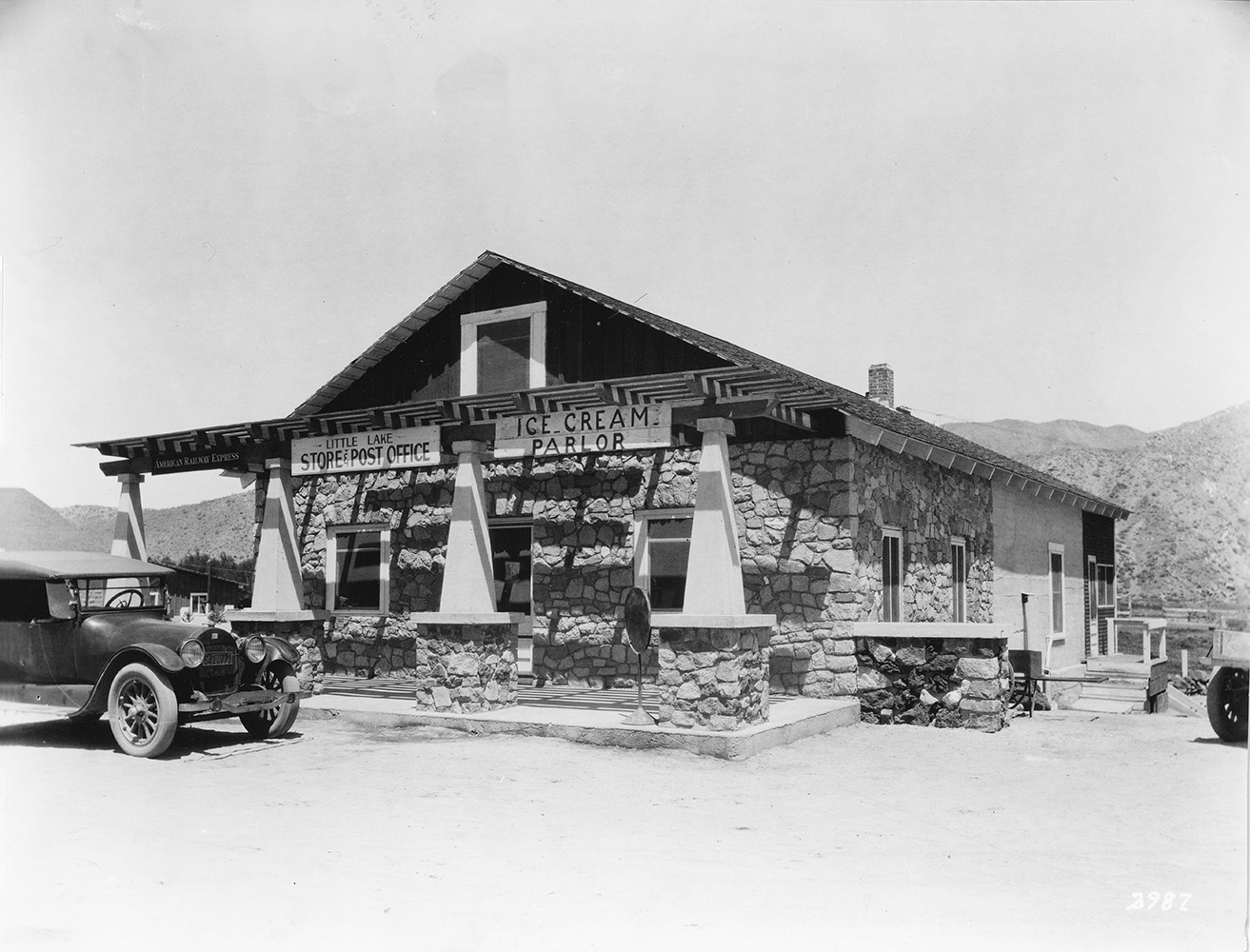 |
| The old Store and Post Office which also had an ice cream parlor - Rich McCutchan archives - owensvalleyhistory.com |
The stone store/post office dated back to the Civil War era! I need to go through the Owens Valley History pages more to see that I'm not confusing two separate structures as the same one, but pretty amazing the area has history going back to the middle of the 1800s! It may be possible that the civil war era structure was more north-south orientated near where the newer Hotel was built.
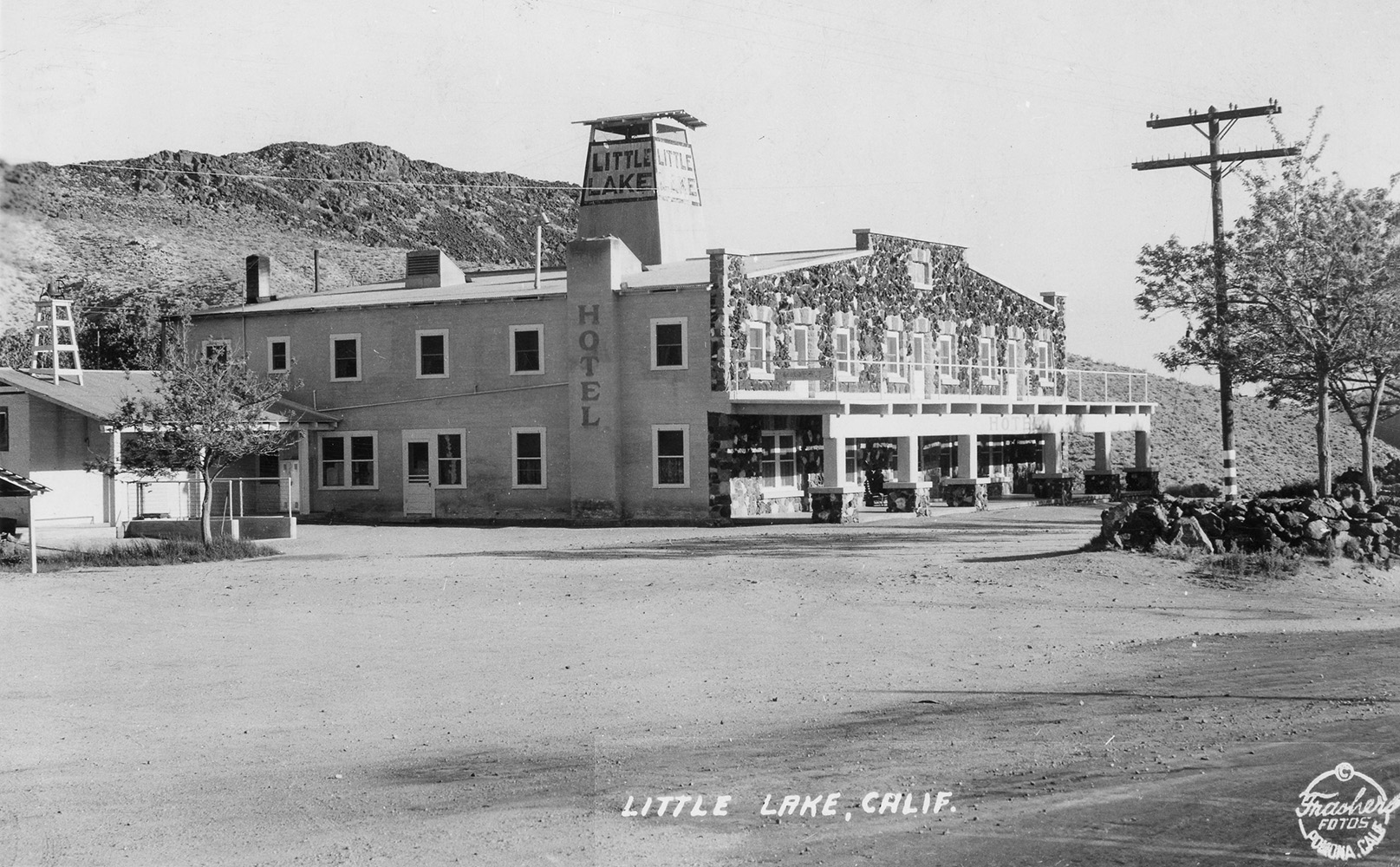 |
| Little Lake Hotel, circa 1946 - Rich McCutchan archives - owensvalleyhistory.com |
I'll probably have to do some selective compression on the large Hotel and push some of the buildings back into the backdrop as flats or only semi-3d structures.
 |
| Postcard of Little Lake Hotel & Store, 1948 - owensvalleyhistory.com |
This view with the extra advertising will probably be the way I model the store and hotel.
 |
| Postcard of Little Lake Store, Gas Station & Garage, 1948 - owensvalleyhistory.com |
By the 1948 era, it seems that the garage, store and hotel have more advertising signage applied than the earlier photos, which probably date to the 1930s.
Fairchild Aerial Survey to the Rescue!
A link on one of the Little Lake forum groups from Bryan Corcoran sent me to the UCSB's FrameFinder GIS page which has a massive collection of photos from Fairchild Aerial Survey covering many years, all the way back to the 1920s! From this site I was able to download great 1944 aerial views of not just Little Lake, but also Bartlett and Owenyo. Truly a great find! I'll probably be going back through with this info and doing another round of update posts about Owenyo and Bartlett!
 |
| 1944 Fairchild Aerial Survey of Little Lake, cropped. North to the Left. FrameFinder from UCSB |
These photos are from high altitude and have very little distortion, so I should be able to bring these into my CAD model for the train layout and have a fairly easy time working the selective compression. The aerial photo of Little Lake is clear enough that I can work out the locations of the switches, spurs, ends of the siding, position and size of the buildings. Interesting that by 1944 the highway fill has been pushed through across the western edge of the lake and the railroad trestle has also been filled in with material.
Railroad Structures in Little Lake
The railroad structures include a tiny "Depot" which consists of a platform where the door of one baggage car/RPO or boxcar could be lined up to for unloading goods and materials off the main track. There's a very small shed on the platform for securing goods which are not ready to be picked up immediately, probably also secured Railway Express Agency parcels.
Little Lake Railroad Depot (MP 468.3)
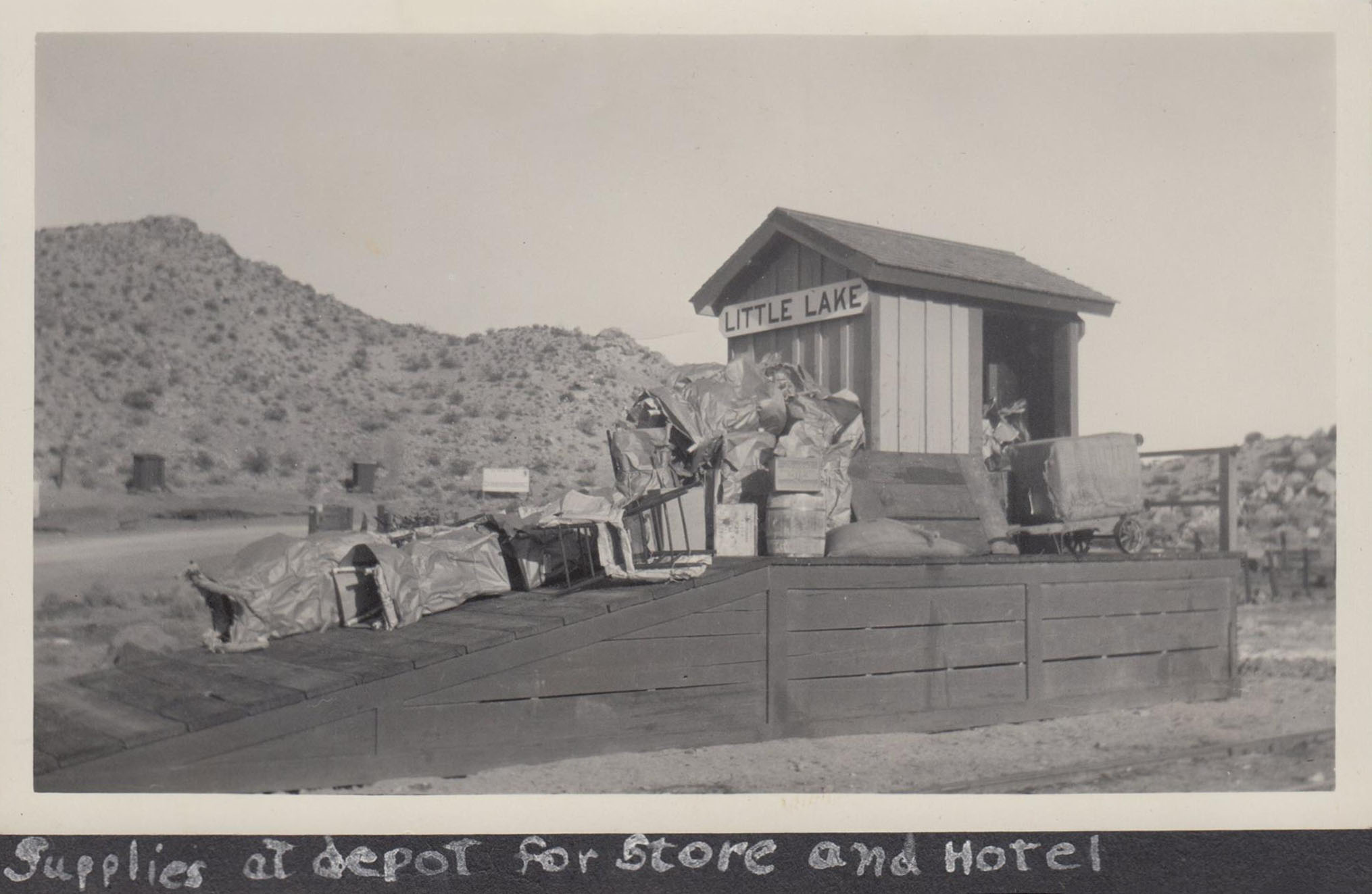 |
| SP Depot at Little Lake - piled to overflowing with supplies for the store and hotel! - owensvalleyhistory.com |
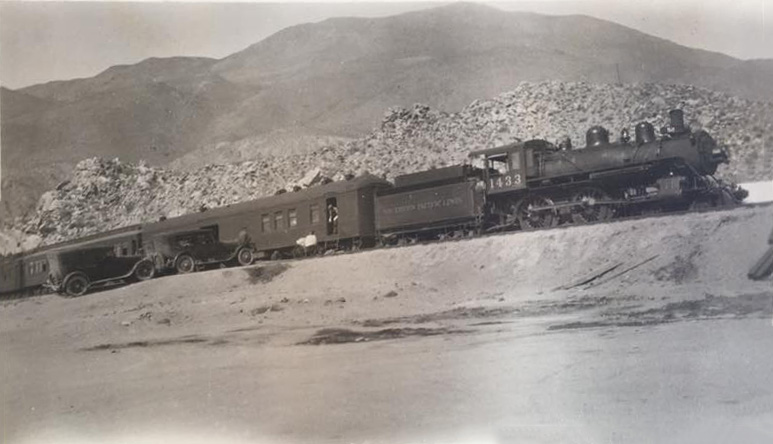 |
| SP 1433 leads a Owens Valley passenger train with RPO and coaches at Little Lake - pre-1938. - Susan Stanton collection - owensvalleyhistory.com |
Given the above photo shows the SP 1433 without aluminum smokebox and Southern Pacific Lines lettering on the tender, so this photo should date from before 1946. Looking up the engines history in Strapac's SP Steam Compendium, the SP 1433's history shows that it was an E-23 class, superheated at Bakersfield on Dec 18, 1918, renumbered as Second SP 1500 on 3-22-38 in Fresno and scrapped on March 11, 1949 at Sacramento.
 |
| Soho 70-BP-30-1 class SP 5130 painted for service as post-1946 lettering. Identical body to the 70-BP-15-3s, which were later rebuilt without the window next to the RPO door. |
An interesting question that arises from this photo is the use of wooden 60ft SP coaches in this shot and the 70-BP-30-1 style RPO, which very well might be one of the 15ft apartment cars of 70-BP-15 which where rebuilt to 30ft cars in the mid-late 1940s.
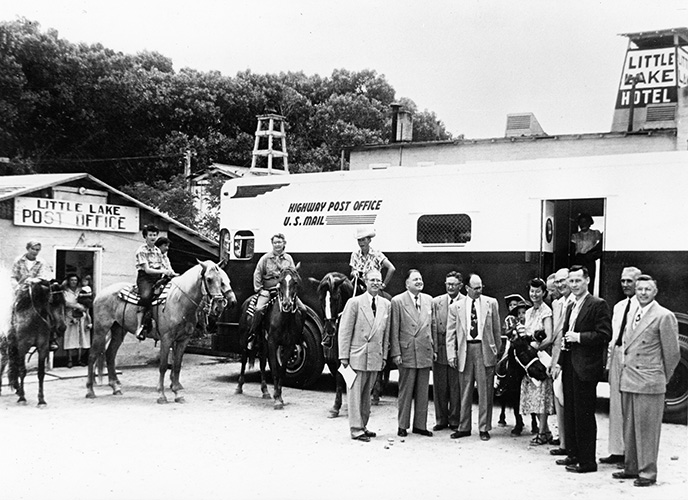 |
| First US Mail RPO Bus/truck trip through Little Lake, July 14,1952 - owensvalleyhistory.com |
I need to do a bit more research as to when the SP's passenger service up the Owenyo Branch ended. I know that the US Mail contracts shifted over to a mail bus out of Mojave on July 14, 1952. However from reading John Signor's Tehachapi, I believe that the scheduled passenger service ended well before then. Something to do more research into.
Ore Dump Ramp
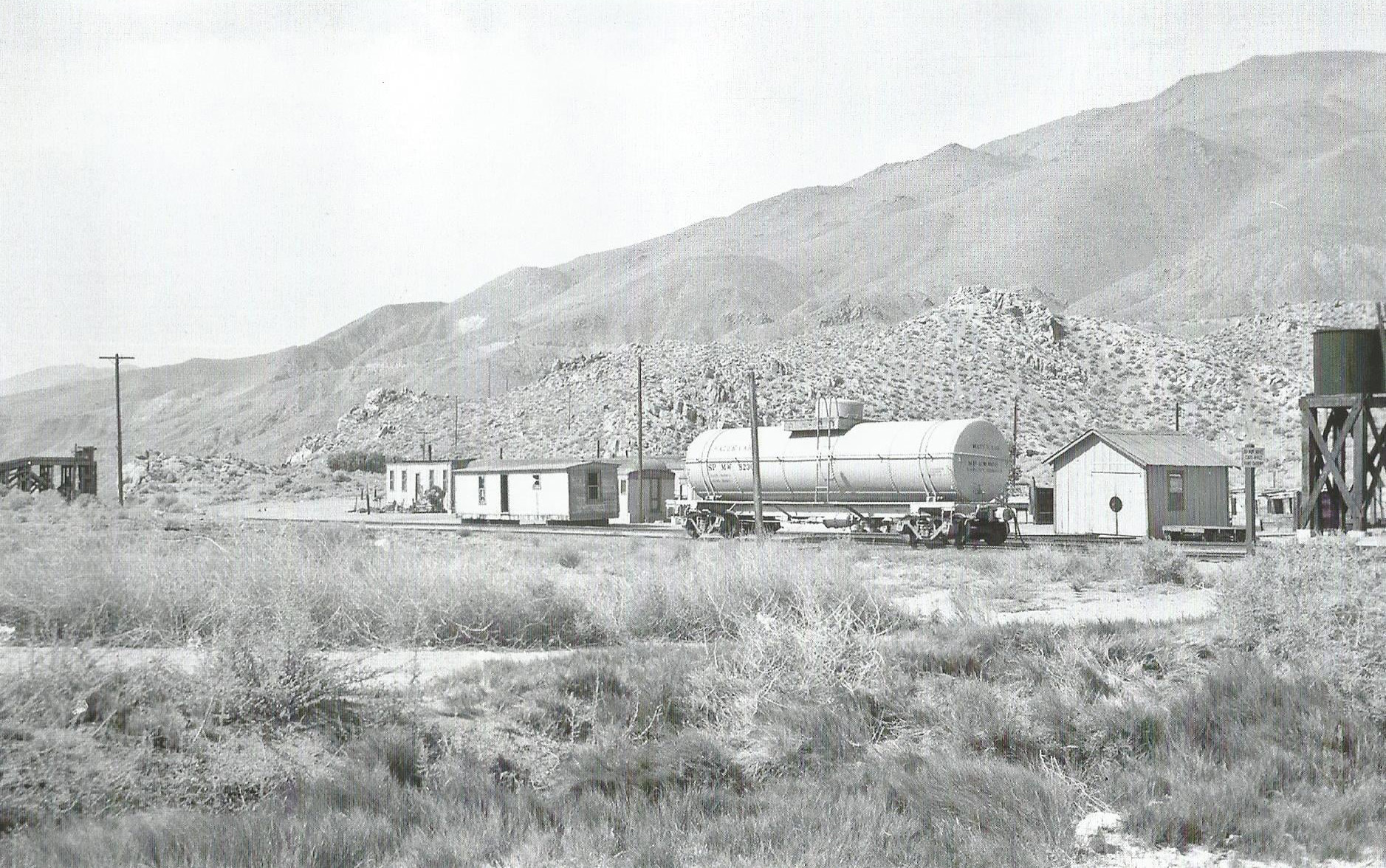 |
| Little Lake "Company Village" - by Alden Armstrong photo, circa 1959 - owensvalleyhistory.com |
The dump ramp at left in the Alden Armstrong photo above is the only one I have showing it clearly. A couple of the other overview photos hint at where it must be, but are so fuzzy they're not going to be of much help. I used Google Earth to help align the closer rock formations west of the tracks with the eastern Sierra features, giving an idea how far north the company village and dump are. It appears that the dump ramp was fed by the trucks accessing directly off of the old highway. (Edit, at least this was by guess before the Fairchild Aerial Survey photo from 1944 shows exactly where the ore dump is!
 |
| Recropped and annotated Fairchild Aerial Survey 1944 photo of Little Lake |
This would probably mean a GS gondola load every week or two as the miners hauled in their loads. Interestingly the dump is located on the Little Lake siding, not the spur. This gives some indication of the operations on the branch not needing Little Lake as a regular meeting point for trains when the dump was built.
Gasoline Storage Tanks?
 |
| Recropped photo of Little Lake from the rocks above the depot showing the edge of the storage tank pumphouse and end of the spur. Original photo link - owensvalleyhistory.com |
Notice that the spur appears to drop down into the area right next to the two gasoline storage tanks. I start to wonder if Little Lake's gas station did enough business to warrant rail-service. I imaging that if an ore gondola got away, the last place you'd want it going is down the spur next to two fuel tanks, above the little town. Which brings up another interesting question... did they have a derail at the south (RR West) end of the siding at Little Lake to keep any cars spotted on the siding from getting away and rolling all the way to Linnie or Inyokern!?
 |
| Recropped view from the south end of town of the gasoline tanks and pump house, plus depot at the left. Original photo link - OwensValleyHistory.com |
Some of the other photos of the branch probably show these cars coming back to Mojave as single cars piled up with open mineral loads, but not coupled to the block of 4-6 GS gondolas from the NG dump trestle at Owenyo.
Railroad "Company Village" 1959
The Section Gang, railroad workers who maintained the Jawbone Branch every 15-20 miles would have a base of operations. These locations would usually have some basic features:
Bunking space for 20-30 men, foremen and other higher level workers may have single dwellings with family space. These accommodations often were in the form of old carbodies from boxcars and passenger cars. Little Lake's bunk space seems to be in the form of three wooden passenger car bodies and one or two wooden boxcars.
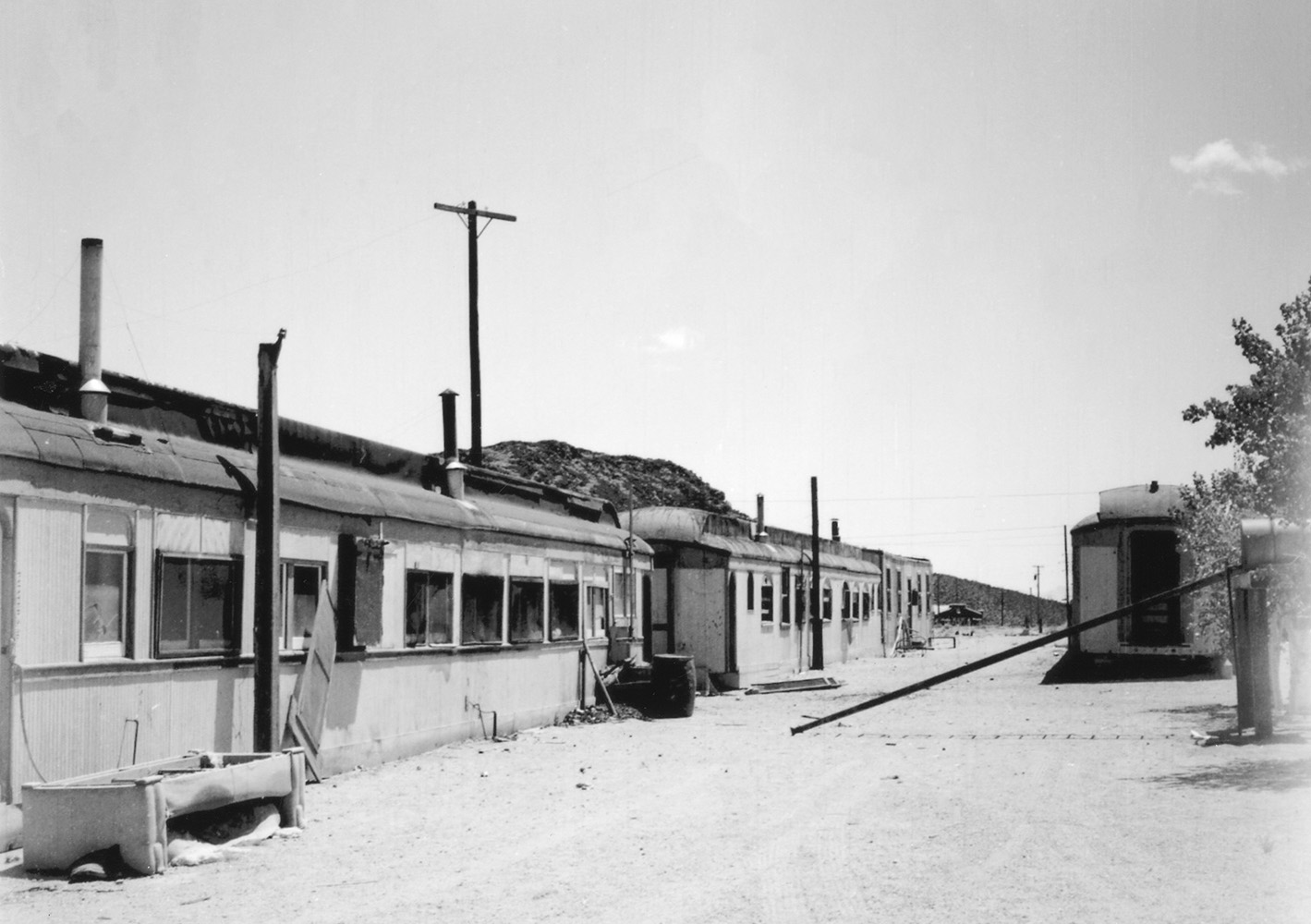 |
| Photo of the Company Village looking South towards the hotel in the distance. Three old wooden passenger cars and a boxcar - owensvalleyhistory.com |
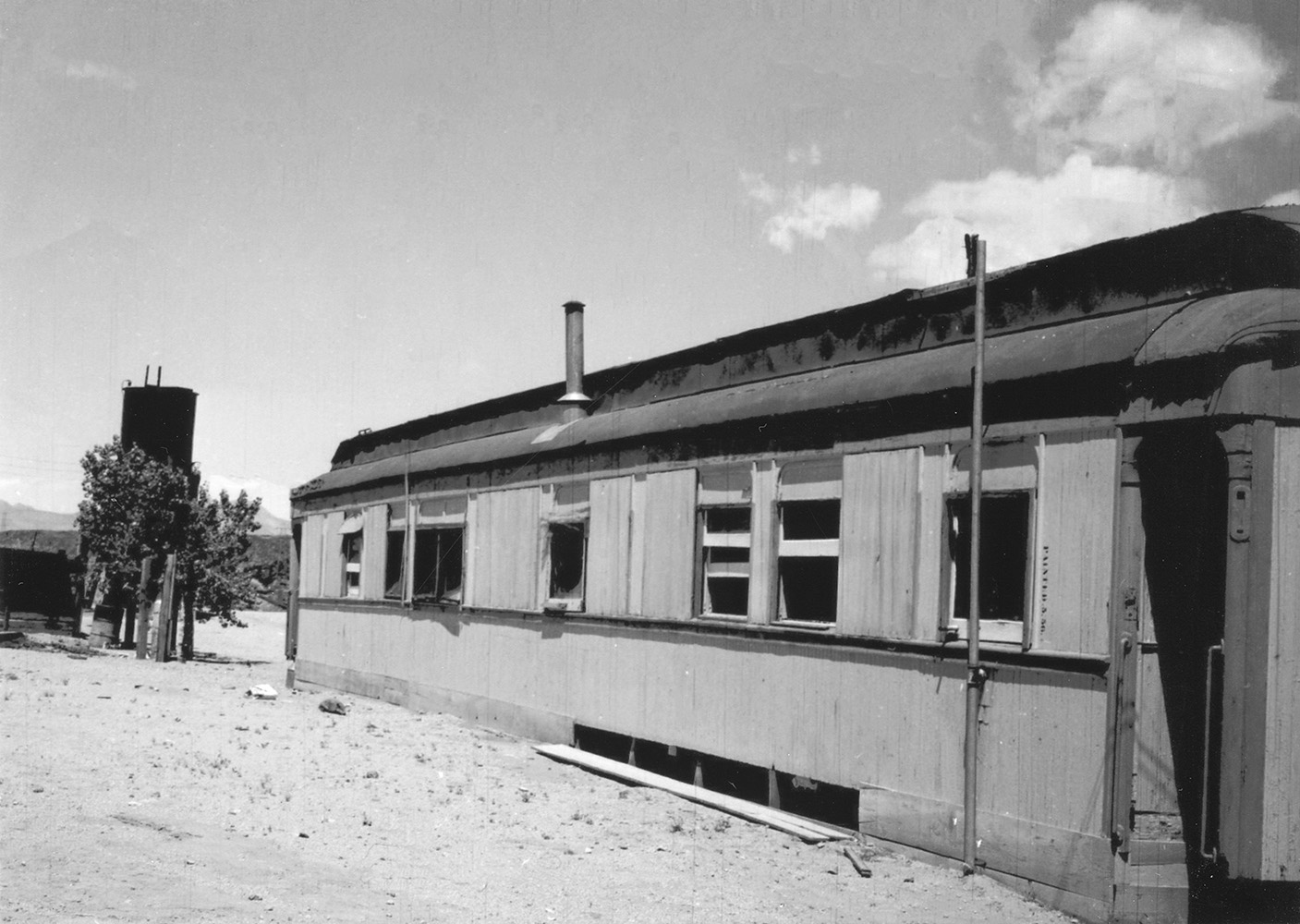 |
| Northern most old wooden passenger carbody and water tank, looking north - owensvalleyhistory.com |
Small water tank of a couple thousand gallons for domestic use. An interesting question is if the water at the company village was from a well or brought in by the SPMW tank car in the Alden Armstrong photo above. Other photos of Little Lake show that the town seems to have been supplied by well water.
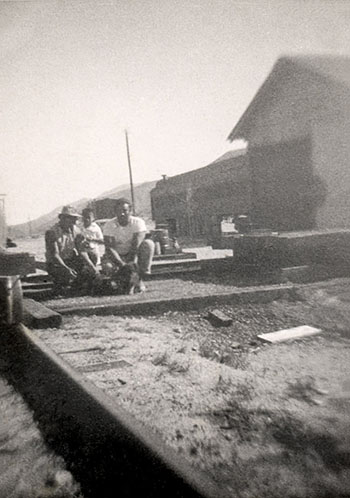 |
| John Olais, Sr and crew next to speeder shed at Little Lake - owensvalleyhistory.com |
Speeder shed for the track inspectors and the gang to move about on their area of the railroad. This shed at Little Lake was located off the main line, east (north) of the village.
 |
| 1944 Fairchild Aerial Survey of Little Lake, cropped. North to the Left. FrameFinder from UCSB |
I've looked up a Fairchild Aerial Survey of Little Lake from 1944, and it clearly shows that the company village was not there. I've heard that the section gangs were at Brown, about 10 miles south of Little Lake. So it's possible that between 1944 and 1959, when the above photos were taken, the section gang base was moved to Little Lake. I hope to ask John Olais a bit more about this part of the history.
SPMW Boarding cars
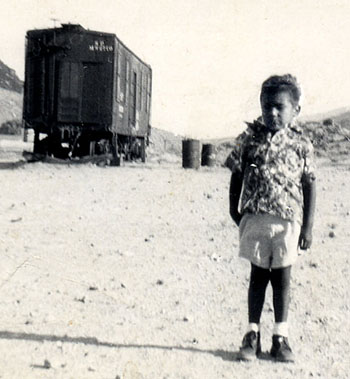 |
| Boarding car in the background - John Olais at Little Lake - Credit owensvalleyhistory.com |
There is a photo, which is a bit blurry, but I'm guessing that the car is SPMW 4240 - B-40-5 which was rebuilt from the wooden boxcar SP 36484 on Dec 31, 1946. This car was located in a spur next to the village, I believe, this car or ones like it are seen in several photos of the SP Owenyo Local working the branchline.
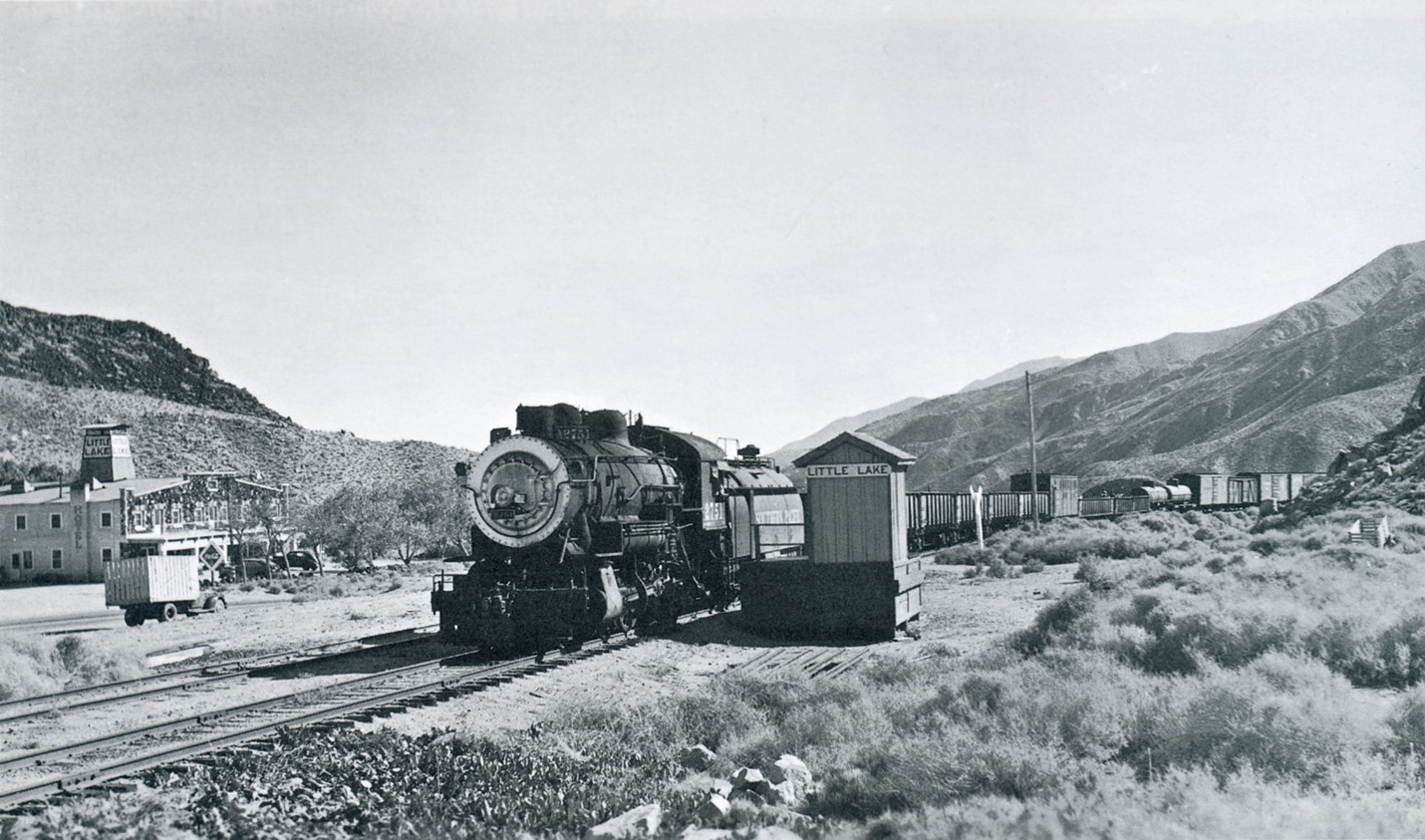 |
| SP Extra 2751 East arrives at Little Lake - Sept 18, 1948 - Notice the SPMW bunk car behind the string of steel GS gondolas. - owensvalleyhistory.com |
There's also a great photo of SP 2751, a 2-8-0 working the Owenyo Local east into Little Lake with a string of steel GS gondolas and a SPMW Bunk car. Unfortunately, I can't really read the number on, but my guess is that this car could be used as a 'camp' car away from the Section Gang's regular base if a crew needed to spend a couple days working on the track somewhere else. The Owenyo Local ran three times a week, one day out, the next day back, so movement of these MW Boarding cars could be planned to layover at a job site for several days at a time.
No More Linnie!?
 |
| No more Linnie - Jason Hill photo, copyright 2002 |
I planned my layout originally to include an space for the little town of Little Lake in the middle of the North Wall, east of where I jog around the bookcases. In doing my new research this week, gathering about 90 photos off the Owens Valley History page, then studying Google Earth and Google Maps, and making a collage of the aerial photos to rough-out where the buildings once stood. This rough map gives me a good starting place for how to lay out the town of Little Lake.
 |
| Little Lake center North wall, Linnie spur NE corner. |
The trouble comes in that the wall is only about 10ft long between the bookcase and the NE corner of the room in which the spur of Linnie is planned to be. In talking with several friends who have been very helpful in my researching of the branch... I'm missing a couple of the really good books on the branch from my library it seems! ...the siding at Linnie was removed in 1947.
The wood chipping operations were started in the mid-1960s and the saw mill built there in the early 1970s, supplied by the lumber operations up Nine Mile Road in and around Kennedy Meadows in the Eastern Sierra. I was hoping to include Linnie since I visited the area in 2002 and was struck by the massive piles of wood chips and bark remaining in the acreage around the site.
Now that this time issue has cropped up (Thanks Jim Summerskier!), while mildly annoying and tripping my anachronisms meter, the issues of Linnie not being an operational lumber producer was partly over-ruled by my "Rule One" (This is my railroad, and I'll built it how I want to!). However....
In Closing - Linnie Replaced!
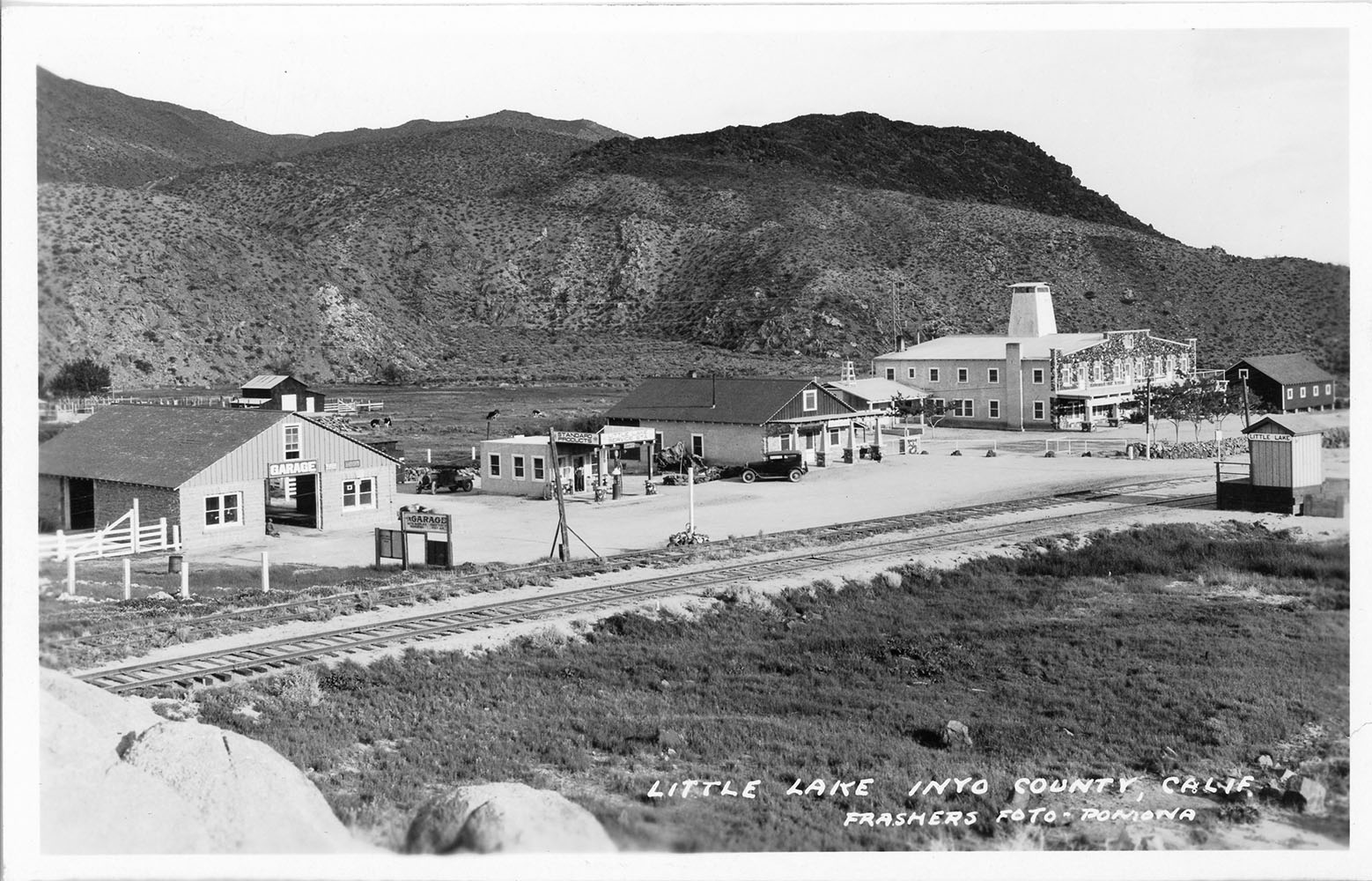 |
| Town of Little Lake 1930s, depot at right - owensvalleyhistory.com |
...However, with the new research of Little Lake and the resulting size increase to get the Hotel at the southern (RR west) end with the other buildings and the 'company village' at the northern (RR east) end of my space, and the natural curve which Little Lake is on, the spur at Linnie I believe will have to go away.
I may decide to stick it outside the curve into Mojave just (drawing) north of Owenyo in the SE corner of the room. There's a window there which I like to have a fan in... soooo, at this point I rather doubt that would be a good idea!
Jason Hill
Related Articles:
SP Jawbone Branch (Part 1) - Concept
SP Jawbone Branch (Part 2) - Researching and Changing of the Plan
SP Jawbone Branch (Part 3) - Consists and More Bartlett Research
SP Jawbone Branch (Part 4) - Freight Car Roster
SP Jawbone Branch (Part 5) - Pulling the Trigger (Buying the materials for the benchwork)
SP Jawbone Branch (Part 6) - Q&A Continuing Design Tweaks - Working out the logistics for the staging yards other details.
SP Jawbone Branch (Part 7) - Film & Construction Begins - Historic movie film clip of Owenyo Local and starting construction of the layout.






















